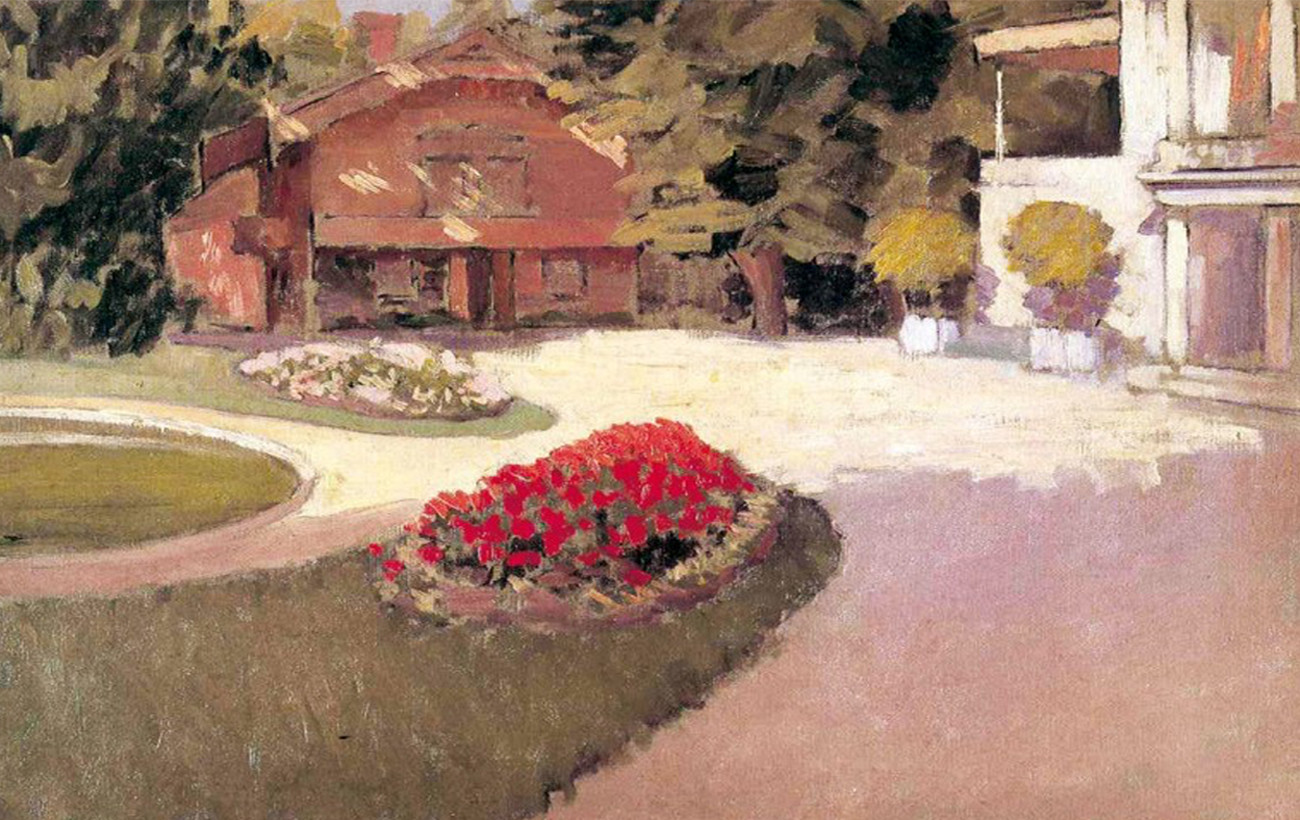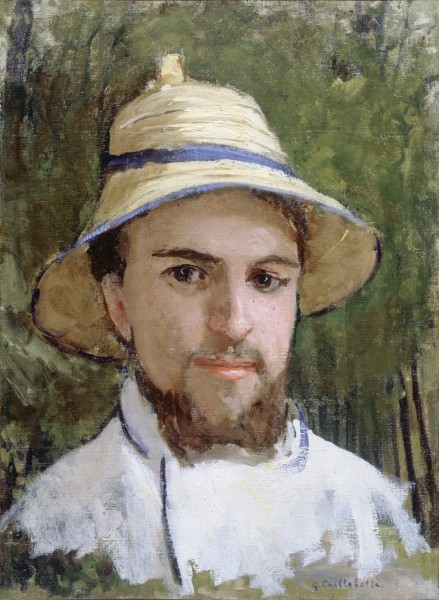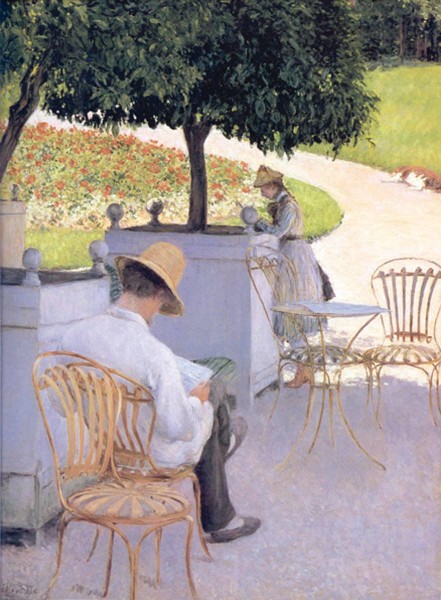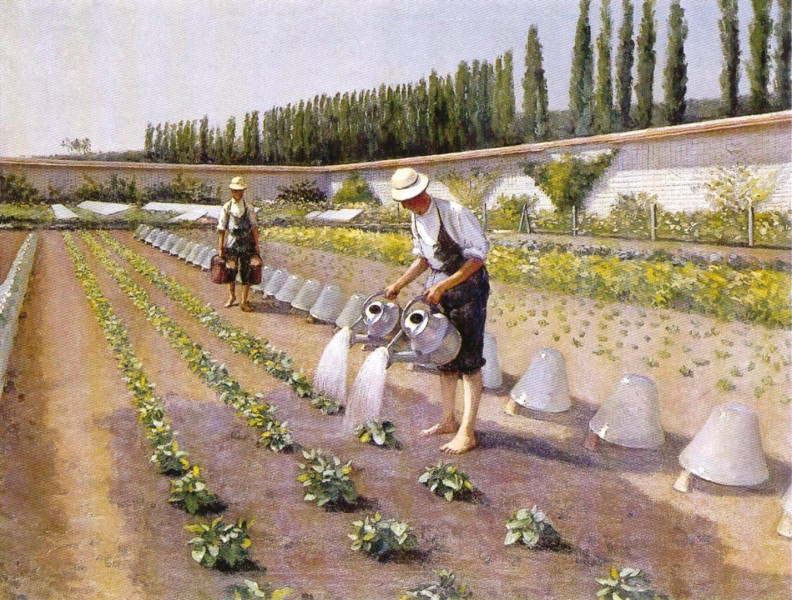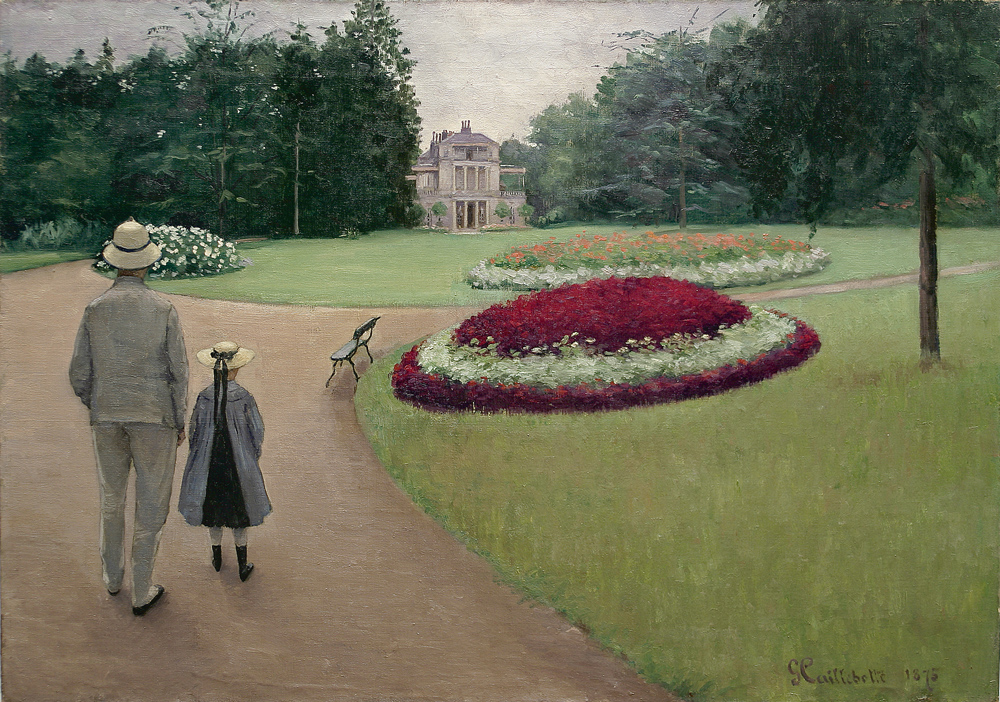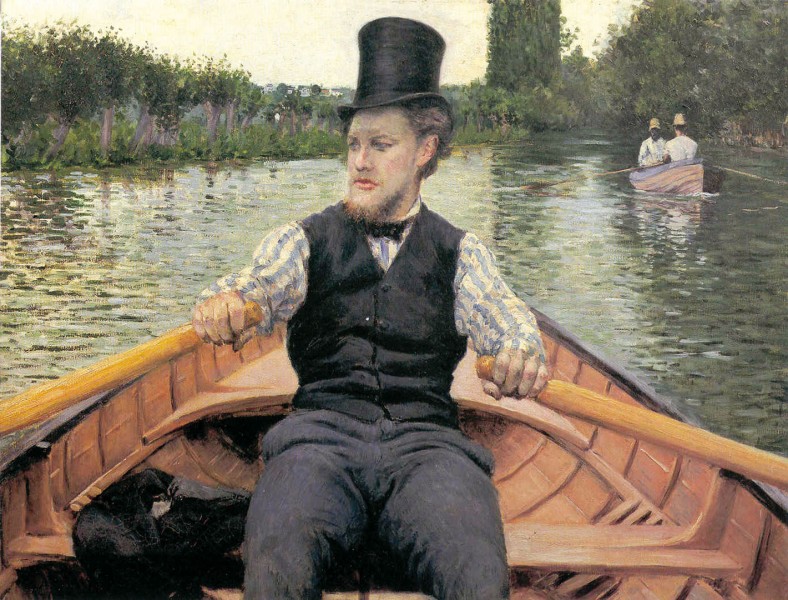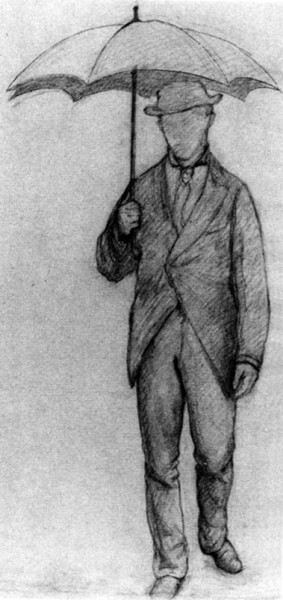Caillebotte exercised his extraordinary talents of painter in Yerres. Although for a very long time he was remembered as the impressionists'generous friend and patron. He also proved to be a nonconforming multifaceted person practising stamp collecting, naval engineering, regatta and horticulture. The man as well as the artist is a fascinating encounter.
The painter and Yerres
Gustave was 12 when the Caillebotte family settled in Yerres. That passing in Yerres is very important in his training and his pictorial inspiration. At that time his father, Martial Caillebotte, was a company manager whose business was quite prosperous and who supplied the army with canvas. As soon as he bought it, he contributed to make the Property and the park more attractive.
Gustave was 12 when the Caillebotte family settled in Yerres. That passing in Yerres is very important in his training and his pictorial inspiration. At that time his father, Martial Caillebotte, was a company manager whose business was quite prosperous and who supplied the army with canvas. As soon as he bought it, he contributed to make the Property and the park more attractive.
The young Gustave opened out within that green setting. As a teenager, he was particularly fond of the flower arrangements and the sinuous paths of the park. All these sources of inspiration can be recognized in the 89 paintings he made within the property. The natural green setting and the leisure facilities of the river are a substancial part in his first paintings. Since then, nothing has changed in the park. A walk in the park will allow you to find the places painted by Caillebotte.
Caillebotte also immortalized his relatives, family or friends spending a few days in Yerres. The characters are caught up in the moment : women sewing, man reading, swimmer in the river Yerres etc... This new style is a total break with academicism. Caillebotte's works, like his contemporaries', exude Realism, sometimes Japanism, since a real attention to detail can be felt.
Probably because he was too audacious, he was not understood, just like his impressionist friends ; Caillebotte will never have the joy of seeing his “Floor Scrapers” shown in the official 1875 Salon in Paris.
The painter has also a passion for boats. In particular he drew plans for sailboats and later set up a shipyard on the banks of the Seine near Argenteuil.
As an artist but also as a patron, Gustave Caillebotte encouraged and supported Renoir, Pissaro, Monet. After his brother René's death 1876 he decided to leave to the State a collection of major works by Sisley, Cézanne, Degas, Monet and Renoir.
When he died in 1894, his friends Renoir and his other brother Martial had his last will fulfilled (will that he had prepared as he had been traumatized by his brother René's untimely death) by leaving some of Gustave works to the State. Today this collection can be seen in the Musée d’Orsay.
Today Caillebotte's other paintings are scattered all over the world.
Caillebotte as a naval architect
Gustave Caillebotte got interested in boats very early : often boating on the river Yerres beside the family property, from 1875 to 1878 he made about twenty paintings with the theme of all kinds of boats, reassuring or unstable ones.
But it's in his house at Petit Gennevilliers on the banks of the Seine river near Argenteuil that he could really develop his passion for sailing; he drew 25 plans for boats that were built in the Luce shipyard near his house. In addition to his numerous activities being an architect kept him busy a lot; Caillebotte indeed also sailed on his own boats (he owned up to 14) and often won races, with Dahud and Roastbeef, his favourite one.... The races used to take place on the Seine but also on the Normandy coast, particularly loved by his parents.
In 1880 Gustave Caillebotte became Vice-President of the Paris Sailing Society, authority of the time for yachting: since then he was very active in promoting and improving that sport at the highest level, thus moving from the architect drawing-board to the helm. It has sometimes been said that Caillebotte had given up painting in the last part of his life but he never forgot to reproduce sailing atmospheres in his paintings, that theme being the favourite one of the painters and writers of those days.
Artistic life
Gustave Caillebotte is at the centre of the artistic revolution which raised political consciousness at the time of the III rd Republic, after the events of 1870 (Franco-Prussian War and Paris Commune).
The emergence of impressionist painters and the contemptuous attitude towards them have become significant milestones in the understanding of artistic modernity.
These painters were criticized : the critics and the Members of the Art Academy could not accept this new style of painting. Gustave Caillebotte who had enough financial resources and clarity of vision had the courage to oppose those contradictory messages. Thus he became « the man to be killed » and was even made fun in mean caricatures in certain press circles (le Charivari).
But these painters were also defended, particularly by the cultural world of writers and poets. At first Zola, as a critic, made Caillebotte a few remarks, before recognizing his true qualities as a painter.
The writer Joris Karl Huysmans has always supported Caillebotte's art. In 1882 he wrote in the magazine « l'Art Moderne » : « Although litterary and artistic injustices don't move me any more, in spite of myself I am still surprised by the continued silence of the press towards such a painter ».
In addition, Caillebotte often organized or participated in dinners for impressionists in famous Parisian Cafés, where artists and writers used to meet : people there talked about art, philosophy, politics... At the Café Riche, Café Guerbois, Gustave Caillebotte often paid the bill for all the guests.
The oblivion of the painter......and his rediscovery
For a long time the painter Gustave Caillebotte was obliterated by his role as a collector and patron of the Impressionists (he collected their works and also paid the rent for Monet's studio), but for a few years he has been recognized by the general public.
After his death in 1894 his work stayed in the shadow while new artistic trends were developing in the XX th century.
Since the retrospective exhibition 1994 at the Grand Palais in Paris, important international exhibitions, in Chicago 1995, Lausanne 2005, Brême 2008, Jacquemart André Museum in Paris 2011, Schirn Kunsthalle in Francfort 2012, then in La Haye and at the Bridgestone Museum of Tokyo in Japan 2013 are important contributions to the knowledge of Gustave Caillebotte's pictorial work.
During his lifetime Caillebotte and his friends took part in exhibitions even if, thanks to his financial comfort, he didn't have to sell. Over the years, as he was getting involved in defending the cause of his impressionist friends, as a painter he vanished. He didn't regard himself on an equal footing as the others. However in 1882 Huysmans wrote « (...) it seems as if he had succeeded in sharping his look, which is, in a normal state, one of the most accurate and original. That painter is a great painter, a painter whose paintings will keep up with the best ones. »
Since 1995 Yerres has been restoring and maintaining the property where the painter made over 89 paintings.
Exhibitions and special events are a constant evocation of Caillebotte's memory.
A world famous painter
Gustave Caillebotte began to be famous as a painter in the United States where some of his works can be seen in 25 museums: the very famous « Paris Street, rainy day » Chicago Institute of Art), « the Orange Trees » ( Houston Museum of Fine Arts), and the paintings entitled "Skiffs" ( Milwaukee Art Museum National Galleey of Art, Washington DC), those ones were painted in Yerres, in the family park and on the river Yerres. Only 12 French museums own some of Caillebotte's paintings.
In 2022 Louis Vuitton Company bought “Partie de bateau” (more than 40 millions euros) to be shown in the Musée d’Orsay.
Caillebotte's international renown was first caused by an exhibition of « Oil Paintings and Pastel Drawings of the Parisian Impressionists », organized by the Art Dealer Durand-Ruel in New York in 1886, where about ten paintings of Caillebotte were included.
In addition, as early as 1886 Caillebotte's brother Martial, maintained contacts with art dealers like Durand-Ruel, Ambroise Vollard and some others : therefore several paintings by Caillebotte could be sold. Quite soon after his death in 1894 his pictorial work was scattered all around. Martial death's in 1910 stopped that movement.
Last but not least at the beginning of the XX th century the Americans played a very significant part on the art market : the presence of American painters in Giverny beside Monet created open channels of communication between the United States and France.
The collector
Caillebotte is very famous as a collector of paintings.
As soon as 1874 Caillebotte became a wealthy heir and so could purchase paintings by Monet, Renoir, Degas: the major aim of these purchases was to help those painters, rejected by criticism, looked down upon by the masses. Caillebotted declared : « nobody wants them, I buy them ».
He became one of the most passionate supports of the independant painters; he played the part of talent agent for exhibitions organized alongside the Official Salon. Thus his vision and his generosity became fully apparent in his life, marked by his 1876 will, announcing the legacy of his collection to the State.
Caillebotte and his brother Martial patiently gathered a stamp collection, even developing a ranking method : in 1887 they sold their collection to M.Tapling, an English philatelist, for a sum of about 5 million euros of 2011. The Caillebotte brothers are recognized as the Fathers of Philately.
A skilled-amateur of gardens
It is often said that Gustave Caillebotte's interest in gardening can be associated to his stay in the Yerres Property. Actually as soon as 1860 his father enlarged the useful gardens at the west end of the lawn. So the surface was approximately doubled up to 5 500 m2 (60 000 square feet ???). Then five gardeners were recruited for the general maintenance of the whole property. We can imagine that as he was curious and enthusiastic Caillebotte probably took part in the activities of the professionals. Later he made several important paintings, such as « the gardeners » inside the kitchen garden; once again the artist showed he was concerned in reflecting the daily life and its utility functions in his paintings.
In the Caillebottes' library you can find the « Complete Manual of the Gardener » by Louis Noisette, a scholarly work published as soon as 1835.
Later, when he was in his property at Petit Gennevilliers, Gustave Caillebotte had his own garden and his orchid green house. His interest in plants is attested by numerous written evidence and letters. With his friends Claude Monet he shared the passion of horticulture and rare plants (poppies, orchids). Caillebotte went several times to Giverny to talk about garden and flowers, a passion he shared with his friend Claude Monet who owned a house in Montgeron, a town near Yerres. Moreover Caillebotte was Monet's best man for his second marriage with Alice Raingo-Hoschedé in 1892. Monet came in the property that gave him the idea to build like in Yerres a bridge (Japanese) over the waterplan.
That passion is reflected in wonderful stil life floral paintings beside paintings of boats whose plans were made by himself.
Caillebotte, painter in his garden in Yerres
In Yerres, his pictorial production took place mainly between the years 1873 and 1878, after Caillebotte, already having a degree in law, chose to devote himself to painting. It includes more than 80 paintings made in the park, mainly including oils on canvas and a few pastels; his work also includes preparatory drawings. He created a few other paintings in and around the village.
He mainly develops 3 themes :
- landscapes in the park: in the ornamental garden, richly planted with trees and maintained by 5 gardeners, he creates paintings treated in a fairly classic style; but Caillebotte works on luminous and colorful effects, on the play of tree trunks, in a way reminiscent of Japonism. Some paintings created in the vegetable garden are imbued with naturalistic atmospheres.
- portraits of families, children, friends: summers in the countryside welcome families and friends, for rest and relaxation.
- leisure scenes in the context of the river: nearly 25 paintings have the themes of nautical activities, boating and perissories, swimming or fishing.
A few interior scenes complete this production.
The styles
The painter develops a very personal and original style.
Art historians recognize in Gustave Caillebotte an art different from the manners most often attributed to the Impressionists: Caillebotte does not seek to work with the rapid, instantaneous touch of the leaders Monet or Renoir, influenced by the theories of Chevreul on complementary colors and divided tones. He tried it in the works of his last period, such as certain landscapes from the Gennevilliers region.
However, Caillebotte, through the choice of realistic themes and open-air atmospheres, joins the Impressionists: he puts a very personal touch into his paintings through a skilful use of perspective and framing, a technique which is found in most of his paintings. great Parisian compositions.
His paintings are compared to a photograph of reality, but Caillebotte brings effects (plays of light, etc.) and a staging that belong only to him.
His technique is a patient construction: for his large compositions he uses preparatory drawings, works with tracing paper, makes sketches.
Most of his work, described in the 2nd catalog raisonné of Marie Berhaut (Ed. Wildenstein 1994), is composed of oils on canvas and a few pastels.
The painting
In oil painting, Caillebotte commonly uses medium-sized formats (around 50 x 60 cm).
The largest formats are: “Rue de Paris, rainy weather” (212.2 x 276.2 cm), “The Bridge of Europe” (124.7 x 180.6 cm) and “Les Raboteurs de parquet » (102 x 145 cm).
These three paintings were the subject of numerous preparatory drawings and variants or sketches.
The drawing
The vast majority of his drawings make it possible to prepare large-scale works. Caillebotte himself says that he works patiently on the creation of his paintings. He uses layers which allow him to study his composition as a director would do when placing his actors.
Caillebotte, although much criticized like the other painters of the movement, was recognized for his science of drawing and arrangement. In addition, sketchbooks and studies in pencil or charcoal have been exhibited on numerous occasions, showing Caillebotte's very elaborate manner.
The pastel
Caillebotte showed a real interest in pastels. He produced more than twenty, dated from 1873 to 1880. We remember that he had collected 8 pastels by Degas, all of which were accepted by the State at the time of the bequest.
It was in the Yerres park that in 1877 he created ten pastels: “Portrait of a Child”, “The Siesta”, “Wall of the Vegetable Garden”, “Prairie à Yerres”, etc.
In the pastels, Caillebotte uses blue, the frequent use of which was criticized, even by its most ardent defenders, such as Huysmans who stated in 1883, regarding the pastel representing Camille Daurelle in the park of Yerres: “(…) and passing in front of a small sign “A Child in a Garden”, where the sin of the terrible blue has been committed again (…). »

